⚡Powering Life's Biochemistry⚡
Explore how bioenergetics and ATP drive energy flow in living systems for optimal health and function.
Understanding Bioenergetics and ATP
Biochemistry of Life
“Life is powered by energy but controlled by precision. In medicine, understanding how cells capture, store, and use energy is foundational.”
What Is Bioenergetics?
Bioenergetics is the study of energy flow through living systems, particularly how the body:
Extracts energy from nutrients
Stores it in usable forms
Utilizes it for biochemical and physiological functions
In medical biochemistry, bioenergetics explains how the body fuels processes like muscle contraction, nerve conduction, active transport, and biosynthesis.
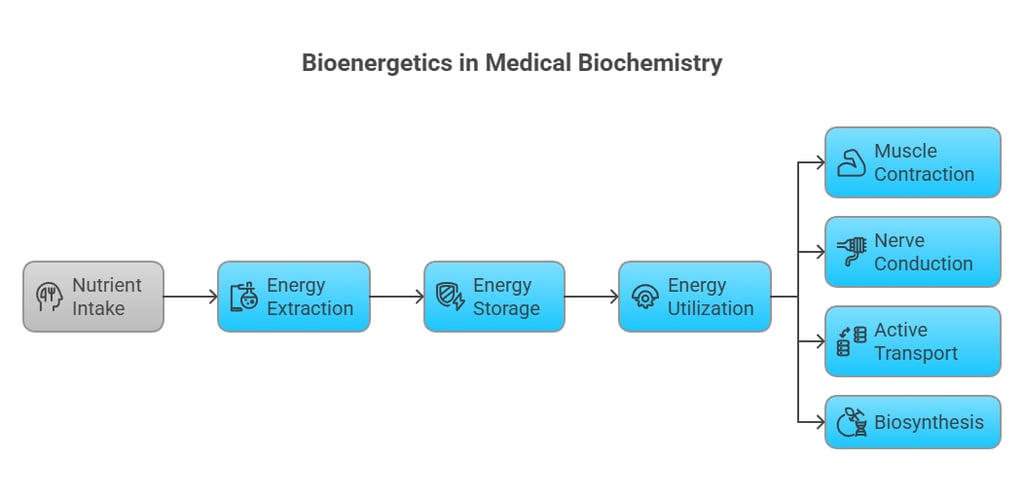

Key Concepts in Bioenergetics
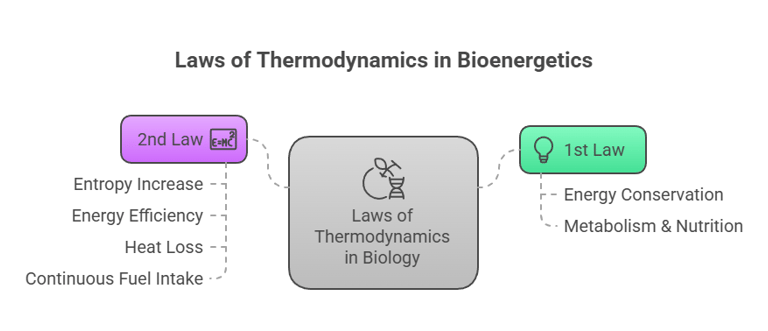

1. Laws of Thermodynamics in Biology
Energy transformations occur with a loss of usable energy as heat. That’s why we need continuous fuel intake
2. Free Energy (ΔG)
The Gibbs free energy change (ΔG) determines whether a reaction is:
Exergonic (ΔG < 0): Releases energy (e.g., ATP hydrolysis)
Endergonic (ΔG > 0): Requires energy (e.g., protein synthesis)
In cells, exergonic reactions drive endergonic ones via coupling.
Clinical Example:
Na⁺/K⁺-ATPase uses ATP (exergonic) to maintain ionic gradients (endergonic)
⚡ ATP – The Energy Currency⚡
What is ATP?
Adenosine Triphosphate (ATP) is a nucleotide composed of:
Adenine (nitrogen base)
Ribose (sugar)
3 phosphate groups
ATP ⇌ ADP + Pi + Energy (ΔG≈−7.3kcal)
ATP is not stored in large amounts but is regenerated continuously via metabolism.
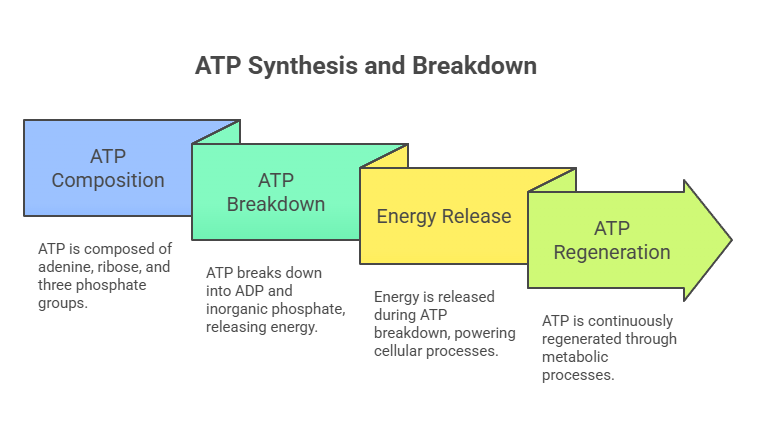

ATP Generation: Where Does It Come From?
1. Substrate-Level Phosphorylation
Direct formation of ATP in glycolysis and the TCA cycle
Does not require oxygen
Example:
PEP + ADP → Pyruvate + ATP
2. Oxidative Phosphorylation (ETC)
Occurs in mitochondria, needs oxygen
ATP is synthesized via chemiosmosis using a proton gradient
Produces ~34 ATP per glucose molecule
3. Photophosphorylation (in plants, not humans)
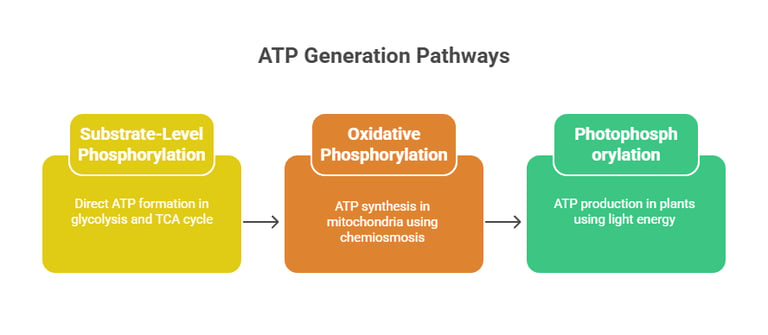

⚡ATP Uses in the Human Body⚡
Mechanical Work: Muscle contraction (e.g., myosin action)
Transport Work: Active transport (e.g., Na⁺/K⁺- ATPase)
Biosynthetic Work: Protein, DNA, lipid synthesis
Signaling: Phosphorylation cascades (e.g., kinases)
Detoxification: Glutathione regeneration
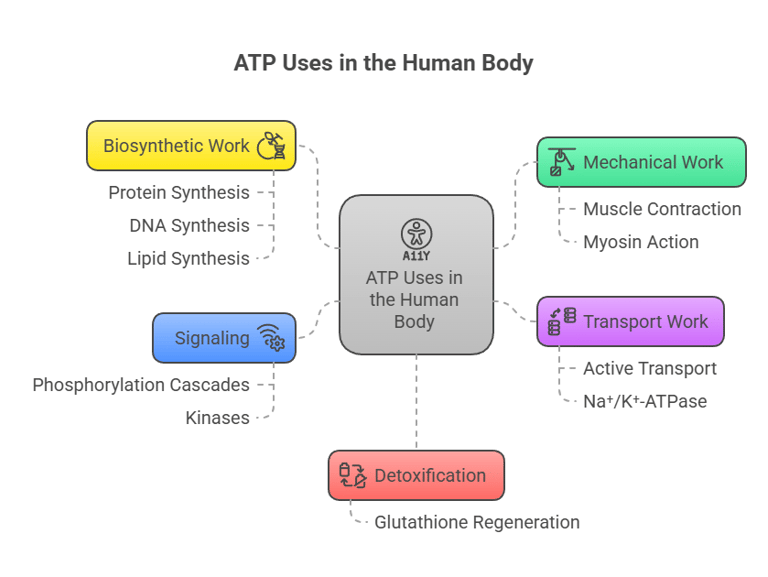

Student Tip: "ATP is not stored; it is recycled."
A resting human uses and regenerates ~40 kg of ATP daily.
One molecule of ATP is recycled 1000s of times per day
That’s why mitochondrial health is critical in high-energy tissues like the brain, Heart, Muscles, and kidneys.
Clinical Correlation
1. Mitochondrial Disorders
Impair ATP synthesis → fatigue, muscle weakness, neurodegeneration.
Example: MELAS, Leigh’s syndrome
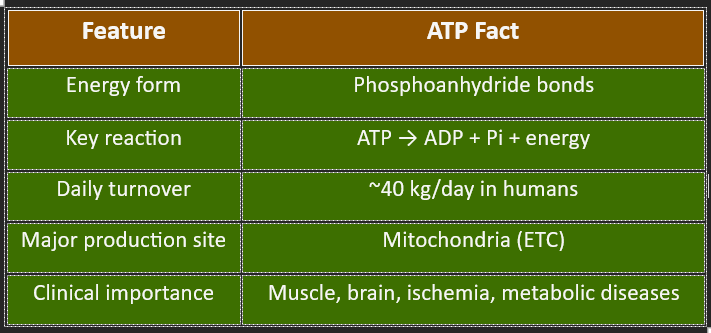

🎯 Final Takeaways
ATP links catabolism to cellular function.
Bioenergetics explains why we breathe, eat, and burn calories.
Understanding ATP is key to clinical conditions like ischemia, fatigue, and metabolic disease.
Every major drug class—from anesthetics to antibiotics—affects cellular energy directly or indirectly
2. Ischemia (O₂ deficiency)
↓ O₂ → ↓ ETC → ↓ ATP → ↑ Anaerobic glycolysis → ↑ Lactic acid → Acidosis
3. Drug Targets
Some poisons (e.g., cyanide, oligomycin) block ETC → rapid ATP depletion
📚 Summary Table
BLOG
Join us to explore medical biochemistry intricacies.
WRITE TO US
© 2024. All rights reserved.
